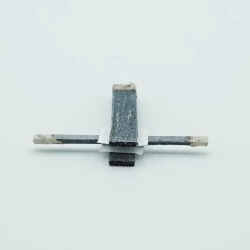
Silicon has always played a starring role in computing. The element is prized for its low resistance, high level of stability, and widespread availability. These factors make the naturally occurring substance ideal for transporting electrons—and data—quickly, efficiently, and cost-effectively.
However, a new branch of electronics has sprouted. Researchers at Linköping University and the KTH Royal Institute of Technology in Sweden have developed the world's first wood transistor. Although it remains far from a functional commercial device—and is not designed to replace CMOS semiconductors—the proof of concept promises to turn a new leaf on computing.
Plant-based transistors could support new types of sensors and devices, while introducing compostable e-waste. "Wood fiber introduces entirely different properties that could lead to new types of electronic systems and new ways to interact with nature," says Isak Engquist, a senior associate professor of organic electronics at Linköping University and a co-author of the March 2023 paper, Electrical Current Modulation in Wood Electrochemical Transistor.
Adds Peter Fratzl, director of Germany's Max Planck Institute of Colloids and Interfaces and editor of the paper, "A more informed use of plant materials—based on a deep knowledge of structure and functional relationships in these natural materials—will introduce high-value uses for plants. This includes wood as an energy storage material, transparent wood, and wood structures used as templates for batteries and electrodes."
A New Branch of Electronics
The boundaries between biotic and abiotic interfaces have emerged as a major area of interest in recent years. Highly flexible polymer-based organic electronics already appear in telephone displays and other devices. However, now there is growing interest in incorporating a variety of materials—from human cells to actual plants—in computing systems. This could sprout entirely new types of computation.
Things like wooden microstructures and water transport channels—highly complex structures templated by natural processes—are the basis of this research, says Daniel T. Simon, organic bioelectronics group leader at Linköping University. For example, wood transistors could lead to an entirely new class of semiconductor that might be integrated with trees and other plants to measure pollutants, or perhaps program fruit production.
Researchers used Balsa wood, which possesses natural channels and a consistent and evenly distributed cellular structure, to support and regulate continuously flowing electricity. "The porous structure of the wood makes it ideal for ion transport and conductivity," says Tran van Chinh, a Ph.D. student who served as a principal researcher on the project and is a co-author of the group's academic paper.
The team transformed the wood into a transistor by removing lignin—an oxygen-containing organic polymer that occurs naturally in trees. This process left the structure with only the long cellulose fibers that support electrical channels. The researchers then filled the channels with a conductive plastic called PEDOT:PSS. The result was electrically conductive wood (CW) that was used to construct a wooden electrochemical transistor (WECT).
In the past, researchers had been limited to merely regulating ion transport in wood; they were unable to build an entire circuit that they could fully control. The group's breakthrough delivers a template for building electrochemical transistors. "Wood is very attractive because it has channels that can handle both ionic and electronic transport, and it's compostable and decomposable," says Engquist.
Wood Chips Go High Tech
Although wood transistors cannot compete with silicon in terms of speed and performance—the wooden transistors operate at only about 1 Hz for now—Engquist and other researchers say the technology could alter the relationship humans have with trees and plants, while introducing entirely new types of devices. "There are many instances where speed does not matter," he says.
For instance, trees with wood circuits could serve as Internet of Things (IoT) devices that process data using embedded living circuits. In addition to switching growth on and off and initialize flowering or fruit production, Simon believes the technology could unleash new nanotechnologies, wearables and medical devices, and even organic energy storage systems that could serve as batteries and supercapacitors.
A big advantage of wood-based circuits over CMOS transistors, Simon adds, is that water, salt, and other corrosive elements will not adversely affect performance or destroy the circuit. As a result, wood or similar bio-based semiconductors could be used in sensitive settings, such as inside the human body or in wet environments. "The technology will likely lead to new and exciting application areas," Simon says.
Nevertheless, it will likely take years for WECT technology to blossom and make a significant impact on the computing world. For now, Engquist, van Chinh, and others continue to experiment with different types of wood, varying orientations of cellular structures, and combining materials with different polymer and conducting properties in order to achieve different results.
"This research is the first major step in developing a new type of transistor—one that greatly expands what's available today with silicon," Engquist concludes. "In the years ahead, wood transistors could have an enormous impact on electronics and sustainability."
Samuel Greengard is an author and journalist based in West Linn, OR, USA.



Join the Discussion (0)
Become a Member or Sign In to Post a Comment